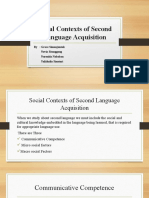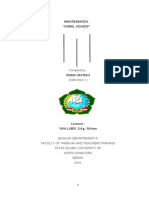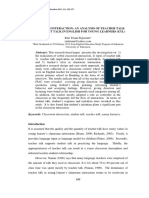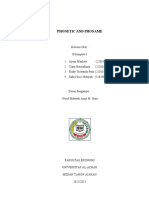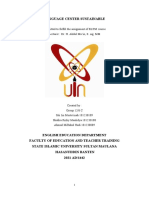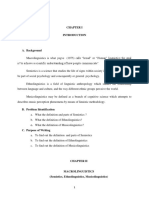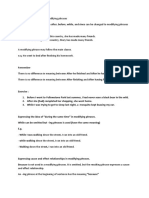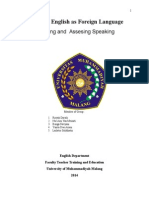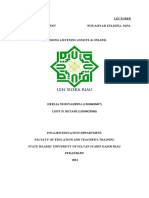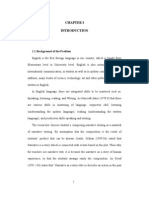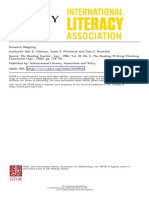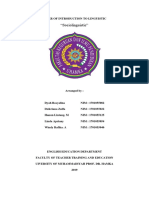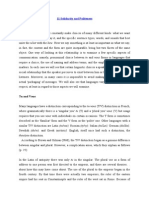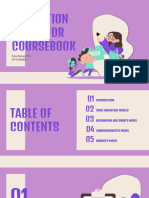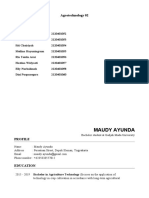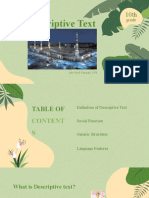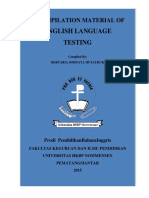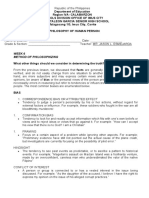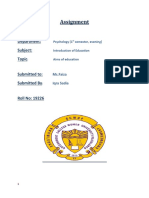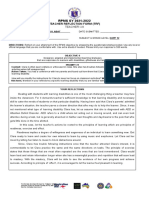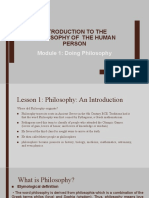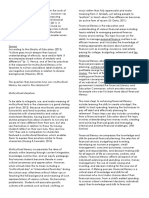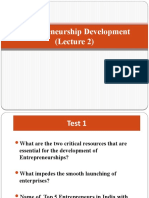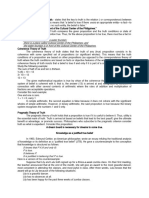PAPER
ADVANCED ASSESSMENT IN ENGLISH
LANGUAGE TEACHING
ARRANGED BY :
BUDI UTAMA (207215018)
EDI ZULFIKAR (207215022)
WIDHARMAWANTA GINTING (207215003)
ZULKIFLI (207215010)
POSTGRADUATE PROGRAM
UNIVERSITY OF MUSLIM NUSANTARA AL WASHLIYAH
MEDAN
2021
� PREFACE
Thank God Almighty, so that we can complete the preparation of this
paper in a very simple form and content .. In the preparation of this paper, we
cannot be separated from the assistance of various parties.
We would like to thank all those who have helped us in compiling this
paper. This paper was created in order to fulfill our obligations as students in
order to fulfill the assignment that has been given in the course Advanced
Assessment in ELT.
This paper is prepared based on existing references and discusses the
problem of assessment in English Language Teaching. In writing this paper, if
there are deficiencies and mistakes, we as writers really hope that all parties can
provide criticism and also suggestions as needed. Finally, hopefully this paper can
provide benefits and learning material for all of us.
Medan, January 2021
Writer
i
� TABLE OF CONTENT
Preface.......................................................................................................... i
Table of Content........................................................................................... ii
CHAPTER I INTRODUCTION
A. Background...................................................................................... 1
B. Problem Statement........................................................................... 2
C. Objective of the Paper...................................................................... 2
CHAPTER II DISCUSSION
A. Assessment....................................................................................... 3
B. Measurement.................................................................................... 6
C. Evaluation........................................................................................ 9
D. Test................................................................................................... 10
E. Teaching and Testing....................................................................... 11
F. What Should be Tested.................................................................... 13
G. Approaches to Language Testing..................................................... 16
CHAPTER III CONCLUSION AND SUGESTION
A. Conclusion....................................................................................... 19
B. Sugestion.......................................................................................... 19
BIBLIOGRAPHY........................................................................................ 20
ii
� CHAPTER 1
INTRODUCTION
A. Background
Education is a necessity that cannot be separated from everyday life. Each
person must have tried to get a good education in the formal and non-formal
institutions. Success or failure of a school is often measured by the results of the
assessment at the end of the learning process, although it is not the sole
determinant tool an education, but it is still used in the world of education.
In education there are a variety of disciplines, including lessons learned.
Lessons include the four skills namely listening, speaking, writing and reading.
All it should also be tested to determine the ability of the already gained during
the study through a test or exam.
Someone language skills to determine whether or not he is in
communication with the people around him. Mastery of language is not only the
mother tongue or regional language but more important is the mastery of a foreign
language, in this case English as a second language. Language skills a person can
be tested with a so called tests of language or language testing, well testing or
language or language assessment.
Questions about the tests to be tested can be made by teachers themselves
or others. Not all teachers understand about the creation of good, quality matter
made or things that need to be tested. Many people do not know how to test the
quality of questions that tested or will be tested. It is also not free from their
1
�ignorance of what is language testing or language tests. Language testing needs to
be known because it would provide the basis for language testing.
Language testing is the practice and study of Evaluating the proficiency of
an individual in a particular language using Effectively. This evaluation to
measure whether students can use the language they have learned to fluently both
in speaking, listening, writing, and reading. This is also used as a gauge whether
students can receive lessons or material submitted by the teachers well.
For this time, we will only discuss the outline of Language Measurement,
Test, Assessment, Evaluation, and what should be tested.
B. Problem Statement
1. What is Assessment?
2. What is Measurement?
3. What is Evaluation?
4. What is Test?
5. What should be tested?
C. The Objective of this paper
The objective of this paper is to explain about assessment, measurement,
evaluation, test and what should be tested. It is hoped that the writing of this paper
will provide benefits to all parties, either directly or indirectly, in an effort to
improve the quality of education in general.
2
� CHAPTER II
DISCUSSION
A. ASSESSMENT
1. Definition of Assessment
Assessment of achievement is what a student has learned in relation to
a particular course content or course objectives. Formative assessment is
carried out by teachers during the learning process with the aim of using the
results to improve instruction. Summative assessment is done at the end of a
course to provide information on program to educational authorities.
Assessment is the process of gathering information to monitor progress
and make educational decisions if necessary. As noted in my definition of test,
an assessment may include a test, but also includes methods such as
observations, interviews, behavior monitoring, etc.
Assessment has a different meaning to the evaluation. The Task Group
on Assessment and Testing (TGAT) described the assessment as all the
methods used to assess the performance of the individual or group (Griffin &
Nix, 1991: 3). Popham (1995: 3) defines assessment in the context of
education as a formal attempt to determine the status of the student regard to
the interests of education. Boyer & Ewel define assessment as a process that
provides information about individual students, about curriculum or program,
the institution or everything related to institutional system. "Processes that
provide information about individual students, about curricula or programs,
about institutions, or about entire systems of institutions "(Stark & Thomas,
1994: 46). Based on the various descriptions of the above can concluded that
3
�the assessment or assessment can be defined as activities interpreting the data
presented.
2. Types of Assessment
The term assessment is generally used to refer to all activities
teachers use to help students learn and to gauge student progress. Though
the notion of assessment is generally more complicated than the following
categories suggest, assessment is often divided for the sake of convenience
using the following distinctions:
a. Formative and Summative
Assessment is often divided into formative and summative
categories for the purpose of considering different objectives for
assessment practices.
Summative assessment is generally carried out at the end of a
course or project. In an educational setting, summative assessments
are typically used to assign students a course grade. Summative
assessments are evaluative.
Formative assessment is generally carried out throughout a course
or project. Formative assessment, also referred to as "educative
assessment," is used to aid learning. In an educational setting,
formative assessment might be a teacher (or peer) or the learner,
providing feedback on a student's work, and would not necessarily
be used for grading purposes. Formative assessments can take the
form of diagnostic, standardized tests.
4
�b. Objective and Subjective
Objective assessment is a form of questioning which has a single
correct answer. Subjective assessment is a form of questioning
which may have more than one correct answer (or more than one
way of expressing the correct answer). There are various types of
objective and subjective questions. Objective question types
include true/false answers, multiple choice, multiple-response and
matching questions. Subjective questions include extended-
response questions and essays.
Subjective assessment is well suited to the increasingly popular
computerized or online assessment format. Some have argued that
the distinction between objective and subjective assessments is
neither useful nor accurate because, in reality, there is no such
thing as "objective" assessment. In fact, all assessments are created
with inherent biases built into decisions about relevant subject
matter and content, as well as cultural (class, ethnic, and gender)
biases.
c. Informal and Formal.
Assessment can be either formal or informal. Formal assessment
usually implies a written document, such as a test, quiz, or paper.
A formal assessment is given a numerical score or grade based on
student performance, whereas an informal assessment does not
contribute to a student's final grade such as this copy and pasted
discussion question.
5
� An informal assessment usually occurs in a more casual manner
and may include observation, inventories, checklists, rating scales,
rubrics, performance and portfolio assessments, participation, peer
and self-evaluation, and discussion.
B. MEASUREMENT
1. Definition of Language Measurement
Measurement is carried out regularly and universally in almost all
activities of people, for example in selling goods, designing buildings, and
diagnosing disease. Henning (1987) highlighted that there could be no science
without measurement. Testing, including all forms of language testing, is one
form of measurement. Just as we weigh carrots, measure the length of a
blackboard, count eggs in a box, or check the volume of a container of water,
so we test reading comprehension or writing to determine to what degree these
abilities are present in the learner. There is potential for error when we weigh
carrots. For example, the scale might not work properly, or it may not be
highly sensitive, so that we need to determine a rough estimate of the correct
weight. Furthermore, the carrots might be wet or dirty, or there might be a few
beets mixed in. therefore, the measurement may be inaccurate in either case.
Correspondingly, test of language abilities may be inaccurate or
unreliable in the sense that repeated measures may give different results.
These measures may also be invalid in the sense that the other abilities are
mixed in. A test of reading comprehension on certain examination may turn
out to be a test of grammar or vocabulary, or at least a few such items may be
6
�mixed in. To be useful, a test must provide us with reliable and valid
measurements for certain purposes.
Measurement is the process of scoring or attempt to obtain a numerical
description of the extent to which a student has reached a certain
characteristic. Measurement results relating to the search process or the
elucidation of quantitative values. Measurement (measurement) is the process
of scoring or attempt to obtain a numerical description of the extent to which a
learner has achieved certain characteristics.
Measurement, beyond its general definition, refers to the set of
procedures and the principles for how to use the procedures in educational
tests and assessments. Some of the basic principles of measurement in
educational evaluations would be raw scores, percentile ranks, derived scores,
standard scores, etc.
Language test is defined as any means of checking what students can
do with language. It may be in the form of question or task that elicits the
students’ ability in the language learned. It is a board definition, including
when to test, who is tested, what, where, how t o test, and why testing.
When : When does the take test take place, before, during, or, after the
language course? Is it an on-going assessment or terminal assessment?
Who : Who and how many students are tested? Is the test intended for
one student, one class, or many students? Who made and administer the
test? Is it a teacher-made test or ready-made test?
7
� What : What to include in the test? Is the sample test representative? Is it
narrow or broad test? What is the range of language used? Does it test
language usage or language use? What type and technique of test is used?
Where : Where is the test administered? Is it in the classroom, outdoor, in
the language laboratory, or in the examination room?
How : How to score the test? Does it use objective or not subjective
scoring? Does it use holistic scoring or discrete scoring? Is it formal or
informal assessment?
Why : why does a teacher administer a test? What is the purpose of the
test? Is it to assist or to asses learning or to see how much the students
have learned (back-looking)? Or to see whether they take the language test
to do something in particular (forward-looking)?
2. The function of Measurement
a. Instructional
1) Principal (basic purpose)
o To determine what knowledge, skills, abilities, habits and
attitudes have been acquired.
o To determine what progress or extent of learning attained.
o To determine strengths, weaknesses, difficulties and needs of
students.
2) Secondary (auxiliary functions for effective teaching and learning)
o To help in study habits formation
o To develop the effort-making capacity of students
8
� o To serve as aid for guidance, counseling, and prognosis
3) Administrative/supervisory
o To maintain standards
o To classify or select for special purposes
o To determine teachers efficiency, effectiveness of methods,
strategies used (strengths, weaknesses, needs); standards of
instruction
o To serve as basis or guide for curriculum making and
developing
C. EVALUATION
1. Definition of Evaluation
Evaluation is the process of providing information to made as
consideration for determining the price and services (the worth and merit) of
the objectives are achieved, the design, implementation and impact to help
make decisions, to help improve accountability and understanding of the
phenomenon. According to the formula, the core of the evaluation is providing
information that can be used as consideration in decision.
Evaluation is the procedures used to determine whether the subject (i.e.
student) meets a preset criteria, such as qualifying for special education
services. This uses assessment (remember that an assessment may be a test) to
make a determination of qualification in accordance with a predetermined
criteria.
9
�D. TEST
1. Definition of Test
A test is a method of measuring a person’s ability, knowledge, or
performance in a given domain. A test is first a method. It is an instrument – a
set of technique, procedures, or items that requires performance on the part of
the test-taker. To qualify as attest, the method must be explicit and structured.
Second, a test must measure. Some tests measure general ability, while others
focus on very specific competencies or objectives. A multi-skill proficiency
test determines a general ability level; a quiz on recognizing correct use of
definite articles measures specific knowledge. Particularly large-scale
standardized test, provide a total numerical score, a percentile rank, and
perhaps some subscorses. If an instrument does not specify a form of reporting
measurement, a means for offering the test-taker some kind of result, then that
technique cannot appropriately be defined as attest.
A test measures an individual’ ability , knowledge, or performance.
Testers need to understand who the test-taker are. What is their previous
experience and background? Is the test appropriately matched to their
abilities? how should test-takers interpret their scores?
A test measures performance, but the results imply the test-takers’
ability or to use a concept common in the field of linguistic, competence.
Finally, a test measure a given domain in the case of a proficiency yet,
even though the actual performance on the test involves only a sampling of
skills, that domain is overall proficiency in a language general competence in
all skills of a language.
10
�E. TEACHING AND TESTING
Teaching and testing are two activities of teachers that can be
accomplished concurrently or consecutively. Testing can be carried out while
teaching is going on.
Testing can also be administered before or after teaching. Heaton (1988:5)
states that testing and teaching are so closely interrelated that is virtually
impossible to work in either field without being constantly concerned with the
other. Tests may be designed chiefly as a device to reinforce learning and to
motivate learners or as a means of assessing the learners’ performance in the
language they are learning.
In the former case, the test is related to the teaching that has taken place,
whereas in the latter case, the teaching is often related to the test.
As language teaching commonly aims at developing the communicative
competence and performance of the learners, a language test should also be design
to measure the learners’ communicative competence and communicative
performance in a language than a mechanical test of structure, which has a a
negative effect on teaching. Heaton (1998) furthermore purposes that a good
communicative test of language should have a much more positive effect on
learning and teaching and should generally result in improved learning habits. In
other words, a good test should have positive backwash effects on learning and
teaching (Hughes, 1989).
The differences between testing and teaching lies on the amount of help
given to the learners. In testing there is hardly any or no help at all given to the
learners, whereas in teaching, the teachers must help the learners as much as
11
�possible in order that they learn the language. The techniques used in teaching
may be the same as the ones used in testing. In reading, the learners may be
trained to identify the main ideas and supporting details of paragraphs using
multiple-choice items or matching as it is done in testing the learners. In writing,
they are required to write paragraph based on a picture or a series of picture, for
example, in both teaching and testing. In listening, they are assigned to listen to a
tape and to fill in the blanks provided or to choose the correct answers. In
speaking, they are interviewed or asked to deliver a speech or make oral report.
Similarly, the language elements, such as vocabulary and grammar, are presented
in the forms of completion, matching, or multiple-choice in both teaching and
testing.
Devies in Hughes (1989) says the good test is an obedient servant since it
follows and imitates the teaching. However, the proper relationship between
teaching and testing is surely that of partnership. It is true that there may be
occasions when the teaching is good and appropriate, and the testing is not. In this
condition, we then suffer from harmful backwash. Equally however, there may be
occasions when teaching is poor or inappropriate and when testing is able to exert
a beneficial influence. Testing cannot be expected only to follow teaching, but
also it should be supportive of good teaching and exert a corrective influence on
bad teaching.
What should teachers do at present is to attempt to measure the students’
success in performing purposeful and relevant tasks and their actual ability to
communicate in the language they are learning. In this sense, such tests
undoubtedly exert a far more beneficial influence on syllabuses and teaching
12
�strategies than the tests did in the past, which mainly tested the structural points
and vocabulary.
To come to the point, testing is the counterpart of teaching. Teaching may
be based on the result of testing, and conversely , testing must be based on the
teaching that has been done.
F. What should be tested?
Indeed, language tests are so complex and so closely to the total context in
which they are used as well as to many non-linguistic skills, such as gesture, eye
movements, etc. That it may often seem impossible to separate from the purpose
of any kind of assessment. A person always speaks and communicates in a
particular situation at a particular time, without this kind of context, language may
lose much of its meaning.
In many situation where English is taught for general purposes, the four
language skills should be carefully integrated and used to performance many
genuinely communicative task as possible. Where this is the case, it is important
for the test writer to concentrate on those types of test items which appear directly
relevant to the ability to use language for real life communication, especially in
oral interaction.
1. Testing the language Skills
The main objective of teaching a language is to enable the students
to be able to use the language in communication. Communication involves
the four language skills. These skill may be measured separately or
integratedly in the combination of two, three, or four skills. Ways of
13
�assessing performance in the four major skills separately may take the
following forms of tests.
a. Listening comprehension may be in the forms of short
utterances, dialogues, talks and lectures, which may be
accompanied with pictures.
b. Speaking ability is usually measured in the form of interview,
conversation, picture description, role-play, and a problem-
solving task involving pair work or group work.
c. Reading comprehension, in which question are set to test the
students’ ability to understand the gist of a text and to extract
key information on specific points in a variety of text forms.
d. Writing ability is usually tested in the form of letters, reports,
memos, messages, instructions, and account of past events, ect.
It is the test constructor’s task to assess the relative importance of
these skills at the various levels and to device an accurate means of
measuring the student’s success in developing these skills. Several test
writers still consider that their purpose can best be achieved if each
separate skill can be measured on its own. But it is usually extremely
difficult to separate on skill from another, for the very division of the four
skills is an artificial one and the concept itself constitutes a vast
oversimplification of the issues involved in communication.
2. Testing the language areas
The language areas may be tested in isolation, using a considerable
number of tests including sections on grammar and usage; vocabulary
14
�(concerned with word meanings, word formation and collocations); and
phonology (concerned with phonemes, stress, and intonation).
a. Test of grammar and usage : A test of grammar measures students’
ability to recognize appropriate grammatical forms and to
manipulate structures. Many test of grammar use multiple-choice
form.
Example :
Fadli ought not to ……………….. me your secret, but he did.
A. tell B. having told
B. C. be telling D. have told
b. Test of vocabulary: A test of vocabulary measures students’
knowledge of the meaning of certain word as well as the patterns
and collocations in which they occur. Such a test may test their
active or passive vocabulary. The test may test recognition or
production.
Example :
Did you …………………… that book from the school library?
A. Beg B. borrow C. lend D. ask
c. Test of phonology, test items designed to test phonology might
attempt to assess the following sub-skills, ability to recognize and
pronounce the significant sound contrasts of a language, ability to
recognize and use the stress patterns of a language, and ability to
hear and produce the melody or patterns of the tunes of a language.
15
�G. APPROACHES TO LANGUAGE TESTING
Language tests can be roughly classified according to four main
approaches to testing, which are listed in chronological order, but they should be
regarded as being strictly confined to certain periods in the development of
language testing. Nor are the four approaches always mutually exclusive. A useful
test will generally incorporate features of several of these approaches.
1. The Essay-Translation Approach
This approach is commonly referred to as the pre-scientific stage of
language testing. No special skill or expertise in testing is required: the
subjective judgment of the teacher is considered to be of paramount
importance. Tests usually consist of essay writing, translation, and
grammatical analysis. The test also have a heavy literary and cultural bias.
2. The Structuralist Approach
This approach is characterized by the view that language learning
is chiefly concerned with the systematic acquisition of a set of habits. It
draws on the work of structural linguistics, in particular the importance of
contrastive analysis and the need to identify and measure the learner’s
mastery of the separate elements of the target language: phonology,
vocabulary, and grammar, which are not based on contexts. The four
language skills are also separated from one another because it is
considered essential to test one thing at a time.
3. The Integrative Approach
This approach involves the testing of language in context and is
thus concerned primarily with meaning and the total communicative effect
16
�of discourse. Consequently, the tests are designed to assess the learner’s
ability to use two or more skills simultaneously. Thus integrative tests are
concerned with a global view of proficiency, involving functional
language. They are best characterized by the use of cloze testing an dof
dictation. Oral interviews, translation and essay writing are also included
in many integrative tests.
4. The Communicative Approach
Communicative tests are concerned primarily, if not totally, with
how language is used in communication. Consequently, most aim to
incorporate tasks which approximate as closely as possible to those facing
the students in real life. Success is judged in terms of the effectiveness of
the communication which takes place rather than the formal linguistic
accuracy. Communicative tests must of necessity reflect the culture of a
particular country because of their emphasis on context and the use of
authentic materials, not the same test is used globally for any country in
the world. Communicative testing is scored based on the concept of
qualitative modes of assessment. Each student’s performance is evaluated
according to his/her degree of success in performing the language tasks set
rather than solely in relation to the performances of other students.
A good test will frequently combine features of the communicative
approach, the integrative approach and even the structural approach –
depending on the particularly purpose of the test and also on the various
test constraints.
17
�18
� CHAPTER III
CONCLUSION AND SUGESTION
A. CONCLUSION
Assessment is the process of gathering information to monitor progress
and make educational decisions if necessary. As noted in my definition of test, an
assessment may include a test, but also includes methods such as observations,
interviews, behavior monitoring, etc.
Measurement is the process of scoring or attempt to obtain a numerical
description of the extent to which a student has reached a certain characteristic.
Evaluation is the procedures used to determine whether the subject (i.e.
student) meets a preset criteria, such as qualifying for special education services.
A test is a method of measuring a person’s ability, knowledge, or
performance in a given domain. A test is first a method. It is an instrument – a set
of technique, procedures, or items that requires performance on the part of the
test-taker.
In many situation where English is taught for general purposes, the four
language skills should be carefully integrated and used to performance many
genuinely communicative task as possible, such as :
1. Testing the language Skills.
2. Testing the language Areas.
B. SUGESTION
Teachers should be able to apply evaluations to teaching and learning
activities carried out in an educational institution because this evaluation will be
able to support the quality and quality of our education.
19
� BIBLIOGRAPHY
Black, Paul, & William, Dylan (October 1998). Inside the Black Box: Raising
Standards Through Classroom Assessment. Phi Beta Kappan. Available at
PDKintl.org. Retrieved January 28, 2009.
Jabu, Baso. English Language Testing. Makassar: UNM Publisher. 2008
http://akbar-iskandar.blogspot.com/2012/09/hubungan-antara-penilaian-tes.html
http://smpsetianegara.wordpress.com/2010/06/07/pengertian-evaluasi-
pengukuran-tes-dan-penilaian-assessment/
Nurhayati, dan Risa Mufliharsi. 2016. Perencanaan Pengajaran Bahasa Inggris.
Jakarta: Unindra Press
Dimyati dan Mudjiono. 2006.Belajar dan Pembelajaran.Jakarta:Rineka Cipta
Ellington, Herry, Fred Pervical, dan Philip Race. 1993. Handbook of Educational
Technology. London: Kogan Page.
Arikunto.2004.Dasar-Dasar Evaluasi Pendidikan. Jakarta: Bumi Aksara.
Mustofa, Parlindungan Pardede. 2007. Reading Comprehension 2. Jakarta:
Unindra
Tia, Muntiah. 2015. RPP Reading Comprehension. Diambil dari:
http://muntiahtamiang.blogspot.co.id/2015/05/rpp-reading-
comprehension.html
Jamdin, Samrin. 2011. Perinsip-Perinsip Penilaian dan Alat Evaluasi. Diambil
dari: http://biologiilmu.blogspot.co.id/2011/03/prinsip-prinsip-penilaian-
dan-alat.html
20




